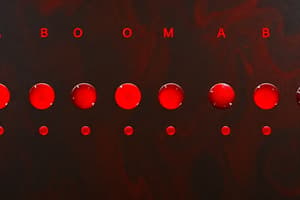Podcast
Questions and Answers
What is the reason for using the base letter L in the MN blood group genotypes?
What is the reason for using the base letter L in the MN blood group genotypes?
- To show the dominance of the N allele
- To honor the discoverers, Landsteiner and Levine (correct)
- To indicate the recessive alleles
- To highlight the dominance of the M allele
In the MN blood group genotypes, which type of arrangement is based solely on alphabetical order?
In the MN blood group genotypes, which type of arrangement is based solely on alphabetical order?
- Presence of MM genotype
- Presence of MN genotype (correct)
- Presence of heterozygote arrangement
- Presence of NN genotype
What is unique about the inheritance of the sickle cell gene?
What is unique about the inheritance of the sickle cell gene?
- It involves a double base substitution
- It leads to anemia due to mutation in hemoglobin
- It results in normal hemoglobin production
- It shows codominance at the molecular level (correct)
Which of these statements best describes codominance as observed in sickle cell anemia?
Which of these statements best describes codominance as observed in sickle cell anemia?
In the context of genetics, what does the term 'phenotype' refer to?
In the context of genetics, what does the term 'phenotype' refer to?
How do codominant genes differ from dominant-recessive genes?
How do codominant genes differ from dominant-recessive genes?
How does sickle cell anemia differ from the MN blood group in terms of genetic inheritance?
How does sickle cell anemia differ from the MN blood group in terms of genetic inheritance?
What does it mean when it is said that both M and N alleles in MN blood type are dominant?
What does it mean when it is said that both M and N alleles in MN blood type are dominant?
What happens at a molecular level in individuals with both forms of hemoglobin (HbA and HbB)?
What happens at a molecular level in individuals with both forms of hemoglobin (HbA and HbB)?
Flashcards are hidden until you start studying
Study Notes
The ABO Blood Group
- Almost all individuals have the H substance on their RBCs, which is necessary for the formation of A and B antigens.
- The H gene is very common, with 99.9% of individuals having an HH or Hh genotype.
Formation of A and B Antigens
- The IA allele expresses an enzyme that attaches N-acetylgalactosamine (AcGalNH) to the H substance, producing the A antigen.
- The IB allele expresses an enzyme that attaches galactose to the H substance, producing the B antigen.
Type O Phenotype
- Individuals with the IOIO allele have a mutation in the I gene, resulting in a non-functional protein and lacking an enzyme to modify the H substance.
- Type O individuals have only the H substance on their RBCs, with no A or B antigen.
ABO Blood Group Genotypes and Phenotypes
- The ABO blood group involves 3 alleles (I^A, I^B, and IO) that can combine to form 4 blood types (phenotypes).
- The 4 blood types are: Type A (A antigen only), Type B (B antigen only), Type AB (both A and B antigens), and Type O (neither A nor B antigen).
- Each phenotype is identifiable by the type of antigen present on the surface of red blood cells.
Codominance in Animals and Humans
- Codominance is observed in cattle, chickens, and horses, where both alleles are expressed equally.
- In humans, examples of codominance include the MN blood group and the inheritance of sickle cell anemia.
- In the MN blood group, both M and N alleles are dominant, resulting in heterozygotes expressing both alleles.
- In sickle cell anemia, codominance is seen at the molecular level, where both HbA and HbB alleles are expressed in heterozygotes.
Studying That Suits You
Use AI to generate personalized quizzes and flashcards to suit your learning preferences.




